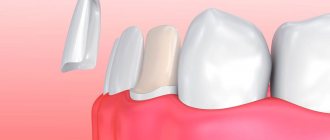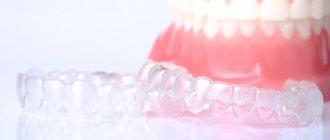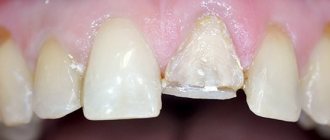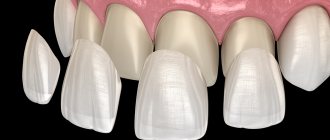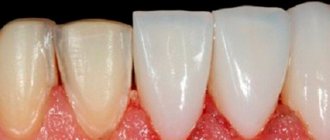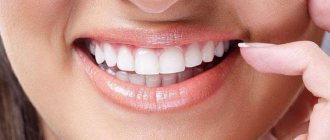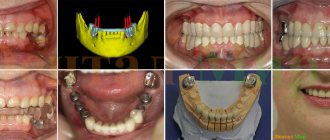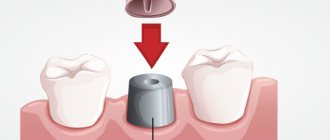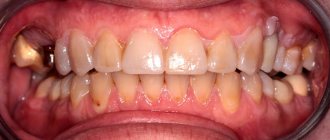One of the most popular treatments in cosmetic dentistry is onlays. Artificial elements imitate the natural appearance of teeth and eliminate aesthetic or pathological problems caused by caries, discoloration, diastema or chips.
They are designed to quickly and naturally improve the appearance of your smile. Composite or porcelain veneers are one of the fastest alternatives. Many people are interested in the following question: is it possible to wear veneers if there are no teeth?
Briefly about veneering
Veneers are the thinnest overlays that are placed on the patient’s own teeth to eliminate aesthetic defects. For high-quality fastening of the plates, living tooth tissue is necessary, therefore, for non-pulp crowns, instead of veneers, the doctor offers a different restoration option.
The thickness of the veneers is extremely small - 0.2-0.5 mm, which makes the products completely invisible on the teeth. Depending on the chosen technology and treatment plan, the dentist can:
- restore the tooth surface directly in the oral cavity using composite compounds;
- take impressions of the patient’s jaw, from which ceramic veneers, zirconium dioxide or porcelain onlays will be made in a dental laboratory.
The procedure for aesthetic restoration with ceramic veneers follows a simple procedure:
- Painless tooth grinding – removal of a layer of tooth enamel to ensure tight fixation of the veneer. The more professional and experienced the doctor, the smaller the layer of enamel is removed. To choose a doctor, you can use the rating of dentists on the 1dentist portal.
- Taking impressions is necessary to create veneers that exactly match the characteristics of the patient’s jaw.
- Attaching temporary onlays - to protect the exposed tooth from unpleasant external influences.
- Installation of veneers already made in the laboratory is tight and reliable.
Thin enamel-colored overlays perfectly mask smile line defects. Veneers are indicated in cases:
- chips or cracks on the surface of the tooth;
- an unsightly filling on an incisor or canine;
- local darkening;
- diastema and trema - interdental gaps;
- mild bite pathologies.
Thin overlays mask aesthetic imperfections and can create a real Hollywood smile – smooth and snow-white.
Ceramic veneers CEREC are fast and comfortable
A sincere warm smile will give you self-confidence and a good mood. But with global problems with teeth, there are fewer reasons for joy. But is there any point in being upset if modern aesthetic dentistry is able to work magic and return such a natural decoration to you? It is easy to simply install veneers on your teeth (the total price is calculated based on the number of units restored) and get an excellent cosmetic effect.
A little bit of advertising:
I am Sergey Samsakov, an orthopedist with more than 10 years of successful experience, I will make and install the most beautiful ceramic veneers for you.
You will have not just beautiful veneers, but exclusive veneers
:
Come for a consultation and make sure that creating an irresistible smile is comfortable and not painful.
And ceramic onlays made using CEREC technology are also fast. Dedicate only 1.5 hours to health and beauty, and I will help you find an impeccable beauty zone plus self-confidence.
Are veneers installed if there are no teeth?
A prerequisite for attaching a veneer is the presence of at least half of the tooth. A similar requirement is made for composite veneers, when the doctor not only restores a damaged tooth, but makes it indistinguishable from others.
In the absence of teeth - complete or partial - the patient will be offered alternative treatment options - prosthetics with the installation of a removable orthopedic structure or implantation with permanent crowns. It will not work to use veneers instead of dentures or implants in treatment, since artificial teeth can be given any aesthetics, and they do not require additional onlays. Moreover, there are no appropriate conditions for attaching veneers during prosthetics, because the plates hold well only on living tissue.
Special cases when solving the problem of whether it is possible to install veneers - if there are no teeth:
- Completely - with complete edentia. Without teeth, there is nothing to attach veneers to, so prosthetics are indicated. The optimal option for the patient is rapid implantation with instant loading using the all-on-4 or all-on-6 protocol.
- One – there is no incisor or fang in the smile area. Veneers cannot be used instead of teeth, but combined treatment is allowed. The dentist will place an implant and an artificial tooth in place of the lost unit and give aesthetics to the entire visible part of the jaw using veneering.
- Several - in the frontal part. The solution is similar to the previous one - implantation and onlays on the remaining teeth to even out the color and structure of the enamel, creating an ideal smile.
- Posterior, chewing - on the upper jaw or lower jaw. Veneers are not placed in this area, and to restore lost functions, the doctor will recommend implantation or dentures - acrylic, clasp.
Do I have to file down my teeth to get veneers?
Answer: no, not necessarily. But first, let's talk about why you need to grind a tooth at all. In some cases, this is necessary so that the doctor can firmly fix the veneer to the enamel. It all depends on the material.
Composite veneers, which are placed in one visit, are literally built onto the tooth, so no grinding is required. To install ceramic linings, you will have to grind off the enamel a little. This guarantees a perfectly tight fit of the lining to the tooth and no problems with caries in the future.
There is a third option - E-max ceramic veneers, which do not require grinding at all! It is enough to just sand the enamel a little. At the Mira clinic we work with veneers of this top brand. This means that our patients do not need to worry about how the tooth preparation procedure will go.
What are implants: features of treatment protocols
So, if you have no teeth at all, veneers are not suitable. Alternative options are removable dentures or implants. Implantation is beneficial for many indications, especially when the patient is completely edentulous.
An implant in dentistry is a multicomponent structure that includes:
- A pin is an implant itself that is implanted into the patient’s bone tissue and acts as a “root” for an artificial tooth. The pin is made from pure medical titanium or a titanium alloy that can integrate into the bone and become part of the bone structure of the jaw.
- An abutment is an adapter responsible for attaching the crown to the titanium pin of the implant. Has different sizes and shapes. Selected by the dentist for a specific type of implant.
- An artificial tooth is a crown made of metal ceramics or zirconium dioxide that can replace a tooth not only externally, but also take over its chewing functions.
When veneers are not possible due to a patient missing one or more units, implants are an excellent choice. Their main advantage is the ability to withstand loads similar to living teeth and create the necessary physiological pressure on bone tissue.
For complete edentia, all-on-4 and all-on-6 implantation protocols are indicated, in which a fixed prosthesis is placed on 4 or 6 implants immediately after the implantation of the pins. The prosthesis completely duplicates the patient's jaw being replaced. This type of implantation is also called one-stage implantation.
What are veneers and why are they needed?
Veneers should be made to restore the aesthetic appearance of your smile. It is better to place them in pairs so that the teeth look the same. The pads look like real ones. You can install up to 10 teeth on both jaws.
Dental veneers are a type of prosthetics that covers the front part of the tooth. As a result, it looks much more aesthetically pleasing.
Veneers are needed if:
- not satisfied with the natural color of your teeth;
- restoration of the integrity of the enamel is required;
- you need to change the size and shape of the tooth;
- Correction of enamel abnormalities is required (for example, if there is hypoplasia);
- to eliminate interdental spaces.
Veneers mask any imperfections, making your smile beautiful.
Veneers instead of implants – is it possible?
Veneers and implants solve different dental problems. The first ones are responsible for aesthetic restoration. They are chosen when it is necessary to restore the color of the enamel or disguise minor defects in the frontal zone of the dentition. The pads are extremely small in size and cannot withstand intense mechanical loads. They cannot replace a tooth.
Implants are used to fully restore a damaged or removed tooth unit. Such an artificial tooth will replace a natural one both in appearance and in function.
Veneers are not synonymous with implants and are not placed instead of them. If you have questions about choosing a treatment regimen, you should contact a trusted dentist in Moscow for professional advice.
When are veneers used?
Let's start with the fact that veneers, thin plates made of composite materials or ceramics, are installed on the vestibular surface of the frontal (and, more recently, premolars) in order to mask multiple small defects. These include: change in enamel color; cracks; chips; interdental gaps and many other imperfections that have arisen as a result of improper oral hygiene or formed due to various dental diseases or the result of their treatment.
A pulpless tooth, that is, a tooth with a removed nerve and a canal filled with filling material, tends to change color after a certain time. A filling, if the dentist does not follow the rules for filling root canals or if low-quality material is used, can also change color, which negatively affects the appearance of the tooth. If the general satisfactory condition of the pulpless tooth and the teeth adjacent to it, an experienced dentist can make a positive decision to install a veneer on it. The choice of treatment method, type of veneer, number of teeth to be restored, as well as the material used to make cosmetic plates depends on the doctor.
If, before placing veneers on pulpless anterior teeth, the doctor considers it advisable to replace old fillings, additional treatment and intracanal tooth cleaning, the patient must strictly follow all instructions. In most cases, the specialists of our dental clinic consider such preparation measures to be mandatory, since thanks to their implementation, the installation of veneers on pulpless teeth becomes not only possible, but also guarantees an excellent result.
What dental defects are not considered unhealthy, but are indications for the installation of veneers?
More often these are aesthetic undesirable features, less often - functional ones. The most common indications for installing veneers are:
- fluorosis;
- a change in the shade of teeth or a naturally dark shade of enamel that cannot be corrected by whitening and professional cleaning;
- irregular shape of individual teeth in a row;
- the presence of diastemas - wide interdental spaces, which are popularly called “gap”;
- if at the moment the tooth is healthy and is not subject to carious destruction, but it has an unaesthetic old filling that cannot be hidden otherwise.
Myths about veneers
13.03.2018
At initial consultations, as well as when presenting a treatment plan, Atribeaute Clinique dentists are often faced with the fact that patients have misconceptions about certain dental procedures. Most often, this concerns the manufacture of veneers. So, today we’ll talk about myths regarding orthopedic dentistry, namely about indirect, ceramic veneers. So, the most common myths about veneers:
1. To install veneers, you will have to cut down your own teeth
This is perhaps the most common myth we encounter when discussing a treatment plan. What is it based on? The thing is that before the use of modern ceramic materials, metal-ceramic structures were popular in dentistry. Ceramics at that time were not perfect (fragile), and they had to be strengthened with a metal frame. But at the same time, a certain volume of ceramics was needed to cover the metal. That is why it was necessary to carry out significant preparation of the tooth tissue, often even depulping the teeth (removing the nerve). But that is a thing of the past.
Modern materials are so durable and aesthetic that minimal treatment of tooth tissue is required. Often, it affects only the limits of the enamel. If restorations have been previously performed on the teeth, then the orthopedic dentist works entirely within the limits of the filling material.
Durability is due to the fact that modern dental laboratories use the so-called E-MAX pressed ceramics, which can be compared to metal in strength, while maintaining unsurpassed aesthetic characteristics.
Comparison of the degree of dental treatment for metal-ceramics and pressed ceramics in the photo:
For metal-ceramic structures:
For E-MAX ceramics:
2. All nerves in the teeth will have to be removed
The reason for this myth is related to the degree of dental treatment, as indicated above. And again, when making metal-free structures, there is no need for devitalization of teeth (removal of nerves).
3. Veneers look unnatural and change the color of the gums.
And again, the reason for the emergence of this myth was the early period of dentistry, when only metal-ceramic structures were made. The color, due to the presence of metal in the structure of the structure, was unnaturally opalescent (not transparent enough). And the change in gum color was associated with direct contact of the oxidized metal with the gum.
Properly made veneers, performed by a good technician, cannot be distinguished from natural tooth tissue, and the gum remains unchanged.
4. Be sure to put veneers on all teeth
Of course, if you want to completely transform your smile or restore the height of your bite, you can do a total job. We, at the Atribeaute Clinique aesthetic dentistry department, have extensive experience in this field and a huge number of satisfied patients. But at the same time, if there is a need to make a single veneer, everything is feasible! An orthopedic dentist in a well-coordinated tandem with a dental technician performs such complex work. Here is an example of one such work:
5. Veneers will change color sooner or later.
Unlike restorations made with composites, which must be periodically polished in order to restore shine and, as a result, brightness to the teeth; Teeth covered with veneers do not require this type of procedure. This is due to the fact that the structure of the composite is more porous and is more susceptible to the absorption of certain pigments. Veneers have an absolutely smooth and shiny surface, so they are not subject to discolouration. But this does not mean that they do not require individual and professional care. This will be discussed below.
6. Veneers constantly chip and can come off at the most inopportune moment.
This statement is most likely based on the unsuccessful experiences of people familiar to the patient. Indeed, such a phenomenon as chipping of a veneer or its loss occurs quite often. But not our patients!!! It's all about following the indications for making veneers. The most important criterion is the question: does the bite allow the veneers to be fixed? That is why, in order to draw up a treatment plan, all our patients undergo a consultation with an orthodontist, who gives the go-ahead for the installation of veneers. If a clinical case requires orthodontic intervention, the bite is first corrected, and only after that, the veneers are fixed. In this case, the above problems can be avoided.
7. I’ll get veneers and forget about my teeth for a long time!
Unfortunately, yes – it’s a myth. You shouldn’t forget about your teeth, even after installing veneers! In addition to daily individual care, using a toothbrush, toothpaste, dental floss and brush, visits to the dentist once every 6 months are mandatory for professional care and examination by an orthopedic dentist. When asked what can happen to veneers and crowns made from artificial materials, we answer that in the absence of proper care, the gums can become inflamed and gingivitis can develop, and in later stages, periodontitis, which can lead to tooth loss. Also, without maintaining hygiene at the proper level, caries can develop at the border of the veneer and tooth tissue. Which again entails the need for repeated treatment procedures. Prevention is better than cure.
These were perhaps the most common myths associated with veneers! To avoid false judgments about modern dental technologies, we recommend asking all your questions to a dentist during a consultation, who will be happy to shed light on a topic that is relevant to you and select an individual treatment method.
What types of veneers are used in aesthetic dentistry: by type of material
The main criterion for classifying overlays is the type of material used. Veneers can be ceramic, made from a composite mixture, etc. All types of overlays differ from each other. The varieties are also installed differently.
Ceramic veneers
Ceramic veneers require indirect prosthetics. They are pre-made in the laboratory and then placed on the patient.
Among the proposals for front teeth, emax veneers are recognized as one of the best. They are as durable as possible and look aesthetically pleasing. Unlike standard ceramic onlays, E-max is made from pressed lithium silicate ceramic. The composition was developed by the leading German company Ivoclar Vivodent.
Cast glass ceramics
Veneers are produced from cast ceramics, characterized by high performance and aesthetic properties. Their performance is superior in comparison with porcelain. The main advantage is that there is no need for preparation.
Hot press ceramics
Veneers of this type are produced using the injection molding method under high temperature. The results are durable microprostheses that are resistant to chewing loads. They are thin and light.
At the same time, the pads are hypoallergenic and more durable. The main disadvantage is the impressive cost.
Traditional feldspar ceramics
Such veneers are made from a special powder obtained during firing and subsequent cooling of the crushed workpiece. The material has high aesthetic characteristics. It is excellent for dental prosthetics, regardless of their location.
Composite veneers
Composite veneers are inexpensive. Their appearance is natural. Overlays are made from a special material that is applied in layers. They are distinguished by ease of installation, but the quality does not suffer from this.
Porcelain veneers (Hollywood laminates)
Porcelain veneers or lumineers are considered one of the main achievements in dentistry. They look like thin plates and are placed on the front of the teeth. The color of the overlay is selected by the patient together with the doctor. Veneers are simply glued on, after etching the surface of the natural tooth to make it rough.
Zirconium veneers with application
These overlays are formed from an alloy with zirconium. The material is highly durable and perfectly compatible with teeth. The effect of its use is excellent. The only negative is the high cost.
Plastic veneers (temporary)
Temporary veneers are used after the enamel has been prepared and impressions have been taken. It takes time to produce permanent overlays. During this period, already ground enamel looks ugly. To hide the defect, temporary overlays are used. They also perform the function of protecting teeth from bacteria, temperature, food and plaque.
Plastic veneers are attached with adhesive and can be easily removed in the dental office.
Removable veneers - they don’t exist
Are there removable veneers? In fact, there are none. The onlays, which appear in advertising every now and then, are attached to 10-12 teeth in a row. They are flat models with imitation gums. They are attached directly to the teeth.
Manufacturers claim that such overlays are suitable for any jaw. In practice, everything looks different.
